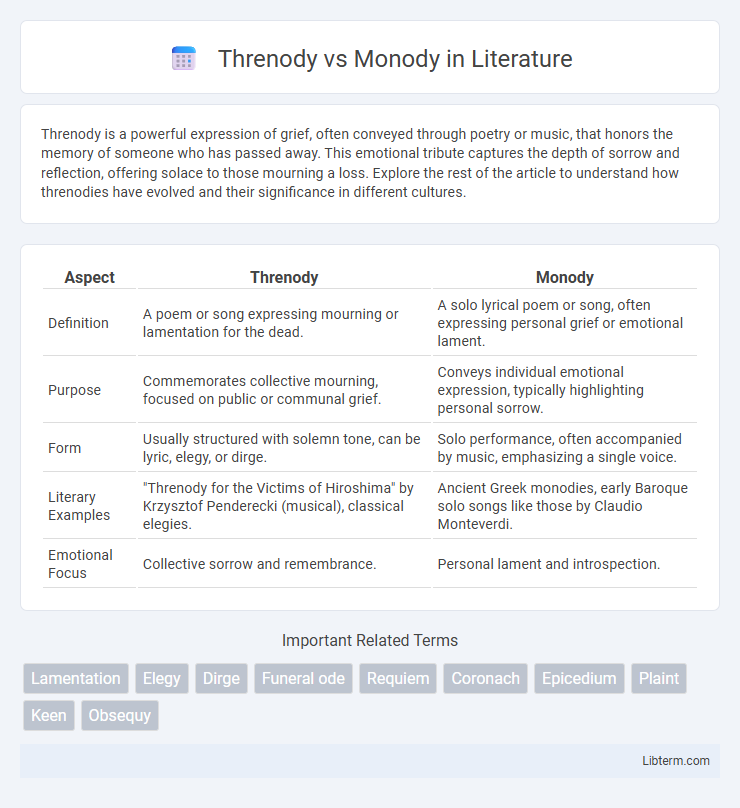Threnody is a powerful expression of grief, often conveyed through poetry or music, that honors the memory of someone who has passed away. This emotional tribute captures the depth of sorrow and reflection, offering solace to those mourning a loss. Explore the rest of the article to understand how threnodies have evolved and their significance in different cultures.
Table of Comparison
| Aspect | Threnody | Monody |
|---|---|---|
| Definition | A poem or song expressing mourning or lamentation for the dead. | A solo lyrical poem or song, often expressing personal grief or emotional lament. |
| Purpose | Commemorates collective mourning, focused on public or communal grief. | Conveys individual emotional expression, typically highlighting personal sorrow. |
| Form | Usually structured with solemn tone, can be lyric, elegy, or dirge. | Solo performance, often accompanied by music, emphasizing a single voice. |
| Literary Examples | "Threnody for the Victims of Hiroshima" by Krzysztof Penderecki (musical), classical elegies. | Ancient Greek monodies, early Baroque solo songs like those by Claudio Monteverdi. |
| Emotional Focus | Collective sorrow and remembrance. | Personal lament and introspection. |
Introduction to Threnody and Monody
Threnody and monody are distinct musical forms that convey deep emotional expression through vocal performance. Threnody is a lament or mourning song, often composed to honor the dead, characterized by sorrowful melodies and somber tones. Monody features a single vocal line with instrumental accompaniment, emphasizing solo emotional expression and narrative clarity.
Origins and Historical Context
Threnody and monody both originate from ancient musical and poetic traditions, yet serve distinct purposes; threnody stems from Greek rituals mourning the dead through lamentation, often performed collectively, while monody emerged in early Baroque Italy as a solo vocal style emphasizing expressive solo melody over instrumental accompaniment. Threnodies are typically linked with communal grieving ceremonies and funerary contexts dating back to classical antiquity, whereas monody, developing around the late 16th century, marked a shift toward individual emotional expression in early opera and madrigal forms. These historical contexts illustrate threnody's role in ritualistic mourning contrasted with monody's innovation in personal, dramatic storytelling through music.
Defining Threnody: Meaning and Purpose
Threnody is a literary or musical composition that expresses deep sorrow and mourning, typically created to honor and lament the death of a loved one or a tragic event. Its purpose is to evoke emotional reflection and provide a solemn tribute through elegiac and melancholic tones. Unlike monody, which often features a single vocal line with instrumental accompaniment, threnody emphasizes collective mourning and communal expression of grief.
Understanding Monody: Form and Function
Monody is a solo vocal style prominent in early Baroque music, characterized by a single melodic line accompanied by simple harmonic support, typically basso continuo. Its form emphasizes expressive clarity and emotional directness, enabling the singer to convey text with dramatic intensity. Unlike threnody, which is a lamentation with multiple voices or orchestral textures, monody focuses on the intimate interplay between voice and accompaniment, facilitating personal narrative and affective expression.
Structural Differences Between Threnody and Monody
Threnody is a mournful musical composition often characterized by complex, layered textures and multiple voices or instruments expressing collective lamentation. Monody features a single melodic line with simple accompaniment, highlighting individual expression and emotional clarity. The structural difference lies in threnody's polyphonic or orchestral arrangement versus monody's solo vocal or instrumental focus.
Emotional Tone and Thematic Elements
Threnody conveys deep mourning and sorrow, often reflecting collective grief or loss, characterized by somber and elegiac tones. Monody, on the other hand, centers on a single voice expressing personal lamentation or longing, creating an intimate and reflective emotional atmosphere. Thematically, threnodies emphasize communal remembrance and the weight of death, while monodies explore individual feelings of isolation and heartfelt expression.
Cultural Significance and Usage
Threnody and monody hold distinct cultural significance, with threnody traditionally serving as a collective lamentation or mourning song that embodies communal grief in various cultures, particularly within funeral rites and memorial ceremonies. Monody, by contrast, features a solo vocal performance expressing personal sorrow or reflection, often linked to the Renaissance and Baroque periods where it emphasized individual emotional depth in poetic or musical compositions. The usage of threnody primarily centers on ritualistic and public expressions of loss, while monody is more commonly associated with intimate artistic settings exploring solitary lamentation and emotional nuance.
Famous Examples in Literature and Music
Threnody and monody both convey deep emotion in literature and music, with threnody often representing mournful laments such as the "Threnody to the Victims of Hiroshima" by Krzysztof Penderecki, while monody features solo vocal lamentations exemplified by Giovanni Battista Pergolesi's "Stabat Mater." In literature, Edgar Allan Poe's "The Raven" serves as a poetic threnody marked by grief and loss, contrasting with monodic expressions found in the solo speeches of Shakespeare's tragedies like Hamlet's soliloquy. These forms harness singular emotional intensity through either communal mourning or intimate personal reflection, shaping their enduring resonance in artistic traditions.
Threnody vs Monody: Key Similarities and Differences
Threnody and monody both serve as musical or poetic forms expressing deep emotion, often centered on themes of mourning and lamentation. Threnody specifically refers to a song or poem of lament for the dead, typically involving multiple voices or instruments creating a somber, collective expression of grief. Monody, in contrast, features a single melodic line, usually vocal, expressing personal sorrow or praise, emphasizing individual emotion over communal mourning found in threnodies.
Modern Interpretations and Legacy
Threnody and monody in modern compositions diverge through their emotional expression and structural frameworks; threnody emphasizes collective mourning with layered dissonance, while monody centers on individual lament marked by a single melodic line. Contemporary composers integrate electronic sounds and experimental techniques to expand these forms' emotional resonance, influencing genres from avant-garde classical to film scores. Their legacy persists in shaping expressive narratives that explore grief and solitude, embedding deep cultural and psychological themes into modern musical storytelling.
Threnody Infographic

 libterm.com
libterm.com